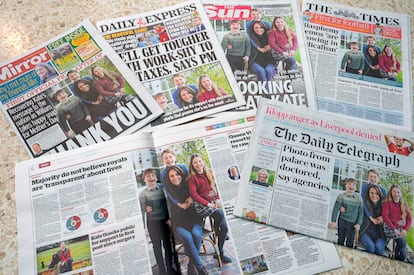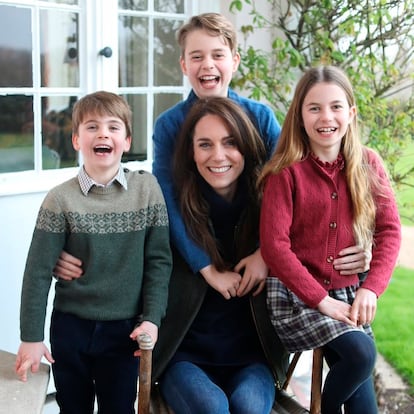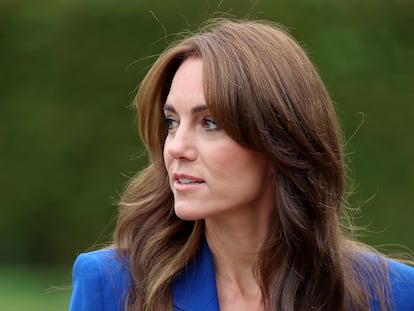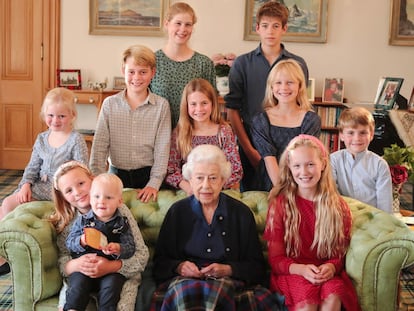Kate Middleton and the edited photo: How are we going to deal in future with manipulated images?
The alteration of reality for political purposes has been happening since the beginning of photography as a communication tool. But the options offered by technology make it easier than ever, forcing the media to take extra precautions

The postcard with one of the most famous photos in history rests like a small treasure in a drawer in my house with the handwritten signature of its author on the back. Yevgeny Khaldei accompanied the Red Army to the fall of Berlin in the throes of World War II. On May 2, 1945, one of the three flags with the hammer and sickle carried by Khaldei, a reporter from the official Tass agency, was placed at the top of the Reichstag, seat of the German Parliament. But, immersed in the excitement of the live performance, he did not realize that one of the two soldiers who appeared in front of the target with the flag was wearing two watches, undoubted proof of the looting. That kind of ostentation was considered unnecessary. As stated in the reproduction that the author himself gave me in 1995, one of those two watches vanished in the laboratory to save the honor of the winning side.
Eight decades later, we continue to live with images that have been manipulated by institutions. What’s more, the digital age and the huge number of editing applications on our cell phones have democratized what was only available to a few in 1945. How are we going to manage all this alteration of reality for political purposes? What tools are going to help us know what is true and what is not?
The debate has jumped into the public sphere following the scandal generated by the digitally manipulated photo in which the Princess of Wales, Kate Middleton, appears with her children. In this case, it was an operation carried out from high levels of power. The consequence has been a loss of credibility and reputation for an institution that, instead of illuminating the truth, has been overwhelmed by a falsehood in its attempt to appease citizens’ desire for knowledge after Middleton was operated on and left without a public agenda.

Photographic manipulation for spurious purposes, even by official sources, is inherent to the photographic medium itself. Today, in an attempt to recover lost credibility, new tools are already being designed to mark the traceability of each image. New legislation in this regard is also evolving. In the middle of this debate is the role of journalism and the media, which complement their news content with images that aim to underpin its truthfulness.
Manipulation has always existed, “but the fact that the monarchy, the power, is getting involved in the issue is something that crosses all kinds of lines,” argues Juan Miguel Sánchez Vigil, professor of Documentation Sciences at the Complutense University of Madrid. “If we purposely manipulate a photo, we are manipulating history,” he insists. The scholar also alludes to the controversy that surrounded a photo of the Spanish royal family in 2022, where the legs of one of the grandchildren of emeritus king Juan Carlos were not visible. Finally, the royal house made public a second take of that scene in which the legs could be seen. As in writing, fiction can exist in photography, and in fact it does, but it needs to be acknowledged, says Sánchez Vigil.
In this sense, the Content Authenticity Initiative (CAI) was founded at the end of 2019 by Adobe, the company behind Photoshop, a well-known image processing program, with the aim of “addressing misinformation and the authenticity” of photos, videos and documents. The initiative has already attracted hundreds of companies from around the world ranging from tech firms to camera manufacturers and media outlets. In the future they hope to add to each image (or document) a label represented by an icon with the letters CR that, when clicked, will indicate its origin and any editing it underwent. This information, which is similar to the information labels on food products, is already being implemented in cameras, mobile phones and photo or video editing programs. That would have made it possible to immediately detect the changes made to the photograph released by the British royal family.
“I don’t think that the purpose of the photo [of Kate Middleton and her children] was deception, although I could be wrong because history is full of examples,” says Paco Gómez, a renowned author of several works of what is known as photographic metafiction. “Also, I think there are no more unmanipulated photos.” In the midst of all the noise, Gómez tries to take the edge off the controversy. “In my opinion it is only a minimally defective touch-up.”
More and more media outlets have a department specializing in detecting false content. Last year, an image from the Reuters agency of the Russian pole vaulter Yelena Isanbayeva, to whom male genitalia had been added to make her seem like a trans athlete, went viral on the social media, as explained by the verification team of Spain’s national public broadcaster, RTVE.
The photo of the Princess of Wales was retracted by the world’s main news agencies when the manipulation was confirmed. Digital manipulation specialist Hany Farid, a professor at the University of California, Berkeley concluded that it was not an image generated by artificial intelligence and that it had not been greatly altered, according to an article he published in Time magazine. That, according to him, explains the apologies offered by Kate Middleton, who took responsibility for the manipulation. But Farid’s conclusions did not quell the allegations of conspiracies and rumors on social media, a world that he describes as “irrational.”
“We live surrounded by doubts,” says Sánchez Vigil, while optimistically predicting that manipulation and artificial intelligence, with which we must live, will end up taking their rightful place. But Professor Hany Farid warns: “People of bad faith will always be one step ahead of the latest software.”
Sign up for our weekly newsletter to get more English-language news coverage from EL PAÍS USA Edition
Tu suscripción se está usando en otro dispositivo
¿Quieres añadir otro usuario a tu suscripción?
Si continúas leyendo en este dispositivo, no se podrá leer en el otro.
FlechaTu suscripción se está usando en otro dispositivo y solo puedes acceder a EL PAÍS desde un dispositivo a la vez.
Si quieres compartir tu cuenta, cambia tu suscripción a la modalidad Premium, así podrás añadir otro usuario. Cada uno accederá con su propia cuenta de email, lo que os permitirá personalizar vuestra experiencia en EL PAÍS.
¿Tienes una suscripción de empresa? Accede aquí para contratar más cuentas.
En el caso de no saber quién está usando tu cuenta, te recomendamos cambiar tu contraseña aquí.
Si decides continuar compartiendo tu cuenta, este mensaje se mostrará en tu dispositivo y en el de la otra persona que está usando tu cuenta de forma indefinida, afectando a tu experiencia de lectura. Puedes consultar aquí los términos y condiciones de la suscripción digital.
More information
Archived In
Últimas noticias
Most viewed
- Sinaloa Cartel war is taking its toll on Los Chapitos
- Oona Chaplin: ‘I told James Cameron that I was living in a treehouse and starting a permaculture project with a friend’
- Reinhard Genzel, Nobel laureate in physics: ‘One-minute videos will never give you the truth’
- Why the price of coffee has skyrocketed: from Brazilian plantations to specialty coffee houses
- Silver prices are going crazy: This is what’s fueling the rally











































